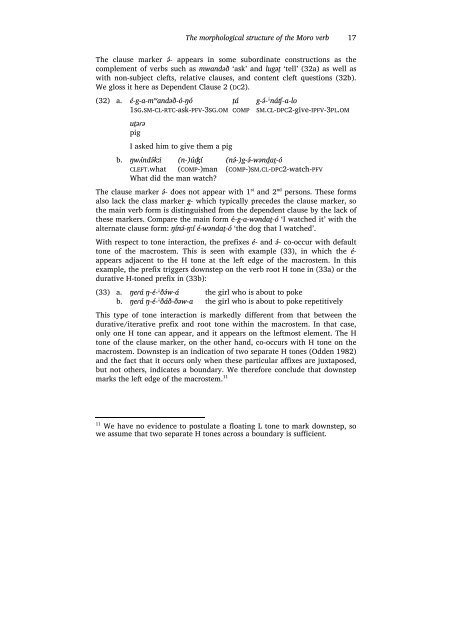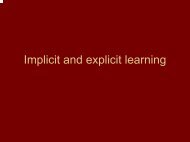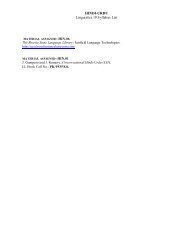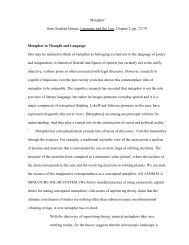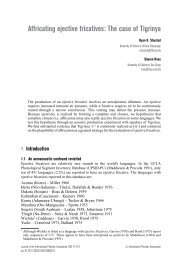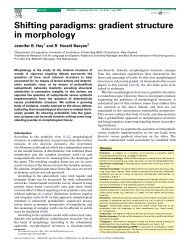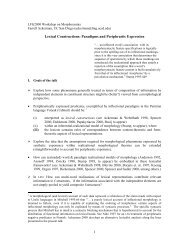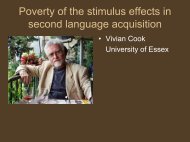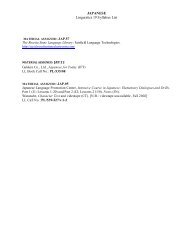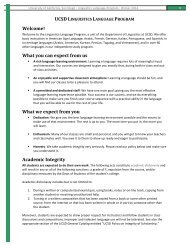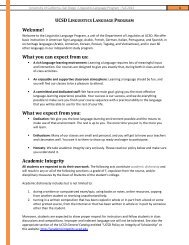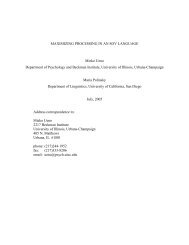The morphological structure of the Moro verb Sharon Rose
The morphological structure of the Moro verb Sharon Rose
The morphological structure of the Moro verb Sharon Rose
You also want an ePaper? Increase the reach of your titles
YUMPU automatically turns print PDFs into web optimized ePapers that Google loves.
<strong>The</strong> <strong>morphological</strong> <strong>structure</strong> <strong>of</strong> <strong>the</strong> <strong>Moro</strong> <strong>verb</strong><br />
<strong>The</strong> clause marker ə́- appears in some subordinate constructions as <strong>the</strong><br />
complement <strong>of</strong> <strong>verb</strong>s such as mwandəð ‘ask’ and lugət ̪ ‘tell’ (32a) as well as<br />
with non-subject clefts, relative clauses, and content cleft questions (32b).<br />
We gloss it here as Dependent Clause 2 (DC2).<br />
(32) a. é-g-a-mʷandəð-ó-ŋó t ̪á g-ə́- ↓ náʧ-a-lo<br />
1SG.SM-CL-RTC-ask-PFV-3SG.OM COMP SM.CL-DPC2-give-IPFV-3PL.OM<br />
ut ̪əɾə<br />
pig<br />
I asked him to give <strong>the</strong>m a pig<br />
b. ŋwʌńdə́kːi (n-)úʤí (nə́-)g-ə́-wənd̪at ̪-ó<br />
CLEFT.what (COMP-)man (COMP-)SM.CL-DPC2-watch-PFV<br />
What did <strong>the</strong> man watch?<br />
<strong>The</strong> clause marker ə́- does not appear with 1 st and 2 nd persons. <strong>The</strong>se forms<br />
also lack <strong>the</strong> class marker g- which typically precedes <strong>the</strong> clause marker, so<br />
<strong>the</strong> main <strong>verb</strong> form is distinguished from <strong>the</strong> dependent clause by <strong>the</strong> lack <strong>of</strong><br />
<strong>the</strong>se markers. Compare <strong>the</strong> main form é-g-a-wəndat ̪-ó ‘I watched it’ with <strong>the</strong><br />
alternate clause form: ŋínə́-ŋːí é-wəndat ̪-ó ‘<strong>the</strong> dog that I watched’.<br />
With respect to tone interaction, <strong>the</strong> prefixes é- and ə́- co-occur with default<br />
tone <strong>of</strong> <strong>the</strong> macrostem. This is seen with example (33), in which <strong>the</strong> é-<br />
appears adjacent to <strong>the</strong> H tone at <strong>the</strong> left edge <strong>of</strong> <strong>the</strong> macrostem. In this<br />
example, <strong>the</strong> prefix triggers downstep on <strong>the</strong> <strong>verb</strong> root H tone in (33a) or <strong>the</strong><br />
durative H-toned prefix in (33b):<br />
(33) a. ŋeɾá ŋ-é- ↓ ðә́w-á <strong>the</strong> girl who is about to poke<br />
b. ŋeɾá ŋ-é- ↓ ðáð-ðәw-a <strong>the</strong> girl who is about to poke repetitively<br />
This type <strong>of</strong> tone interaction is markedly different from that between <strong>the</strong><br />
durative/iterative prefix and root tone within <strong>the</strong> macrostem. In that case,<br />
only one H tone can appear, and it appears on <strong>the</strong> leftmost element. <strong>The</strong> H<br />
tone <strong>of</strong> <strong>the</strong> clause marker, on <strong>the</strong> o<strong>the</strong>r hand, co-occurs with H tone on <strong>the</strong><br />
macrostem. Downstep is an indication <strong>of</strong> two separate H tones (Odden 1982)<br />
and <strong>the</strong> fact that it occurs only when <strong>the</strong>se particular affixes are juxtaposed,<br />
but not o<strong>the</strong>rs, indicates a boundary. We <strong>the</strong>refore conclude that downstep<br />
marks <strong>the</strong> left edge <strong>of</strong> <strong>the</strong> macrostem. 11<br />
11 We have no evidence to postulate a floating L tone to mark downstep, so<br />
we assume that two separate H tones across a boundary is sufficient.<br />
17


